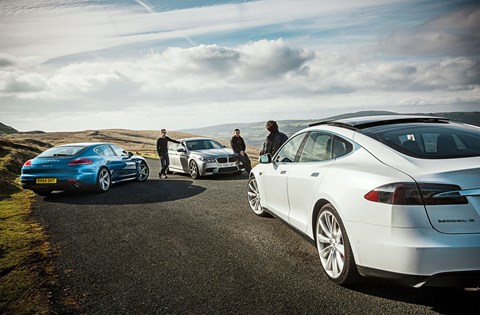► CAR magazine Giant Test of sports saloons
► Electric Tesla vs hybrid Porsche vs petrol BMW
► Three very different approaches, only one winner
Here’s a scary stat: when consultancy Accenture surveyed 14,000 drivers, 39% declared in-car technology most likely to swing a car purchase. Only 14% ranked performance top. Into this shifting automotive landscape drives the all-electric Tesla, an automotive iPhone that you plug in at night and hope won’t die during the day.
Tesla is based near San Francisco. In that Californian bubble, from which technological innovation and pollution regulations trickle through to us all, Tesla is on a roll. With one model, it’s the state’s third largest premium brand, outselling Porsche, closing in on BMW and Mercedes; it’s portentous enough to send premium brands scurrying to their R&D bunkers.
But here’s the catch: a Model S probably won’t run out of juice in California. Tesla’s ‘supercharger’ network – the iTunes of gas stations, where only a Tesla can charge – is advanced, and half a charge takes 20 minutes.
The UK’s best electric cars and EVs
Tesla in the UK: a practical proposition?
For UK buyers, things are more restrictive: there are 22 charging points, mostly down south. You can use other charging outlets, but you’ll kick your heels for hours. So the point of this test is to take the Tesla out of its comfort zone. We’ll drive it to some great Welsh roads that those urban early adopters might never experience, and see if we can stray far from a Supercharger without gnawing fingernails. How many miles can we cover? Is the Model S actually any good to drive?
What’s more, how does the Model S stack up against more conventional premium saloons? Should you really drop £70k on a Tesla with a limited range and nascent charging infrastructure, when there are plenty other fast, luxurious saloons you can refuel almost anywhere in minutes?
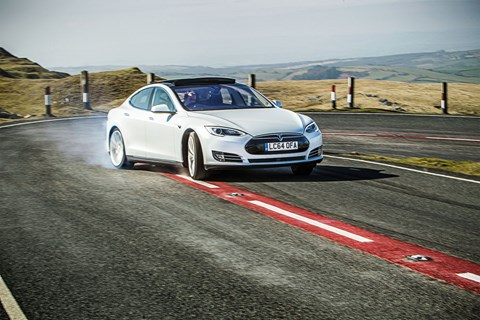
This test car is the rear-drive, 375bhp Model S. You’ll get a Model S with a 60kWh (kilowatt hour) battery and 240-mile range but no supercharger compatibility for £56k. Ours upgrades to an 85Kwh battery with 310-mile range and supercharger compatibility for £69k, including £5k low-emissions grant.
From Porsche we’ve got the second-generation Panamera S E-Hybrid, its advanced tech signalled by luminous socks for brake calipers. Gone is the nickel-metal hydride battery, replaced by lithium-ion for up to five times more power. The hybrid bit doesn’t just mean you harvest wasted power from the combustion engine; you can also plug the Panamera in for up to 22 miles of emissions-free motoring at up to 84mph. It takes between 2.5 and four hours to juice, depending on charge point.
This allows Porsche to claim 91.1mpg and 71g/km CO2. The government thinks the Panamera so clean it’ll give you that £5k rebate (£89k all in), plus free road tax and entry into London’s Congestion Charge Zone. So you get many of the fiscal benefits of the Tesla, with a 410bhp V6 you can fuel countrywide.
Ancient and modern: petrol vs electric
Those of you in the 14% bracket who like having fun between A and B might prefer the 592bhp BMW M5. Compared with the Tesla, it’s like the Exxon Valdez on 20-inch rims. At least it’s trying: a downsized, twin-turbocharged V8 boosts oomph compared with the old V10, and also returns a much improved 28.5mpg and 231g/km of CO2.
The M5 is odds-on the best driver’s car here, but can a hybrid saloon from the sports-car kings trouble it on a great road, and can Tesla even come close to those kicks? Tesla wins the eco bragging rights, but just how more frugal is the Porsche than the M5 outside the EU lab?
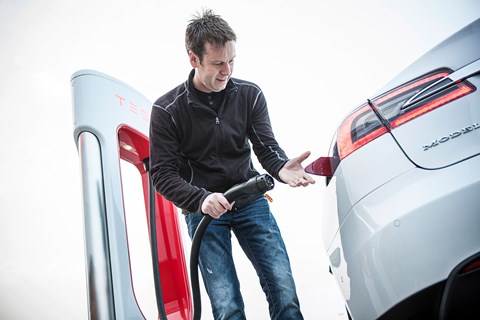
We hit a sizeable setback on discovering there are no Tesla superchargers in Wales. So our CJ drives to Bristol, where Sainsbury’s has a pair of chargers. It takes 90 minutes to fully charge the Tesla, which arrived one-third charged.
We’re told the Panamera should’ve been fully charged before leaving Porsche. It won’t engage E-mode when I try pressing it en route, but I have driven this car around Silverstone, where the green rev needle stuck eerily to zero for long periods at surprisingly high speed. This time either someone didn’t charge it, or they used the fizz on the journey; our schedule didn’t give us time to plug it in.
The Panamera essentially uses an Audi powertrain, a 3.0-litre supercharged V6 with some orange high-voltage wires under the bonnet and an eight-speed torque converter auto – no dual-clutch PDK here, note.
It’s a pleasant few hours in the Porsche’s luxuriously appointed interior, my initial 30-minute cross-country blat giving way to steady-state motorway cruising. Shame the Panamera feels lethargic in its default mode, like a pillow’s jammed under the throttle. When you back off, a coasting function kills the revs, and there’s a small lull when you demand more thrust. It’s a ponderous feeling at odds with Porsche’s sporting DNA.
In Sport mode, the Panamera quits coasting and feels altogether more lively. It’s the best of both worlds; the response of a supercharged engine with the perky push-in-the-back of electric thrust. Feels strangely perverse not to maximise the Panamera’s efficiency, though, so I kill Sport and my sandals barely touch the accelerator for two hours.
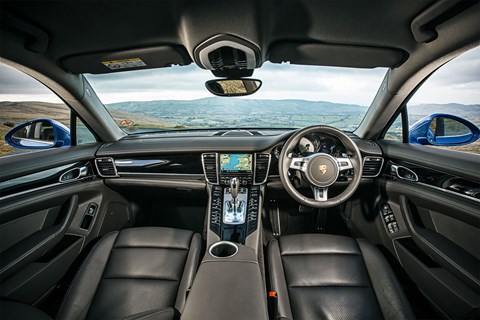
When I arrive in Bristol, there are a couple of charging bays at nearby Asda, snatched from the disabled parking area outside the front door. For the first time in my custody, the Porsche is at a standstill and engages E-mode. It’s surprisingly over-sensitive to throttle tickles as I reverse. Then I realise the charging station requires a card that I have to sign up for. My oversight, but would an owner in unfamiliar territory research the nearest charging point, then ensure they’d signed up to the relevant charging scheme? No, they’d fill up on liquid fossil. Really, the E part of the Panamera is better suited to the daily commute, with one charger at home, one at work.
The next day, I drive a Tesla for the first time. The first we heard of PayPal billionaire Elon Musk’s automotive venture, it’d taken a Lotus Elise and replaced the polluting bits with batteries. Not easy, but the complex stuff – making doors fit, ensuring glass keeps out the elements, giving people a chance of survival in a head-on smash – had at least been been taken care of by Lotus.
The Model S is all Tesla’s work; the only thing you’ll notice is the Mercedes switchgear. From a distance it looks like a futuristic Maserati, and it is impressively mature for a car with no heritage. But up close you notice both passenger-side doors have dropped a few millimetres, and that the bonnet shutlines don’t properly marry up. It looks like a Cat D.
The Model S senses the lozenge-shaped key as you approach, popping open flush-fitting door handles in welcome. Then you press the brake and pull the column-shift selector to D and you’re away; no start button, no twinkly welcome music, no handbrake release. You just waft off like someone turned on the dodgems.
Inside the Tesla cockpit: meet the future
Inside, the lack of a traditional powertrain or existing vehicle architecture has given Tesla’s engineers almost unprecedented freedom. So there’s a giant iPad thing in the centre console, no transmission tunnel, and a snowboard-shaped tray between the front seats to hold oddments.
It’s futuristic and impressive, but also reeks of movie-set facade, like they know the cameras won’t zoom in. The finish – mostly leather, and a modern wood-grain-like fillet running through the dash on our highly optioned car – is sophisticated, the feel airy, but there’s a hollow resonance when you tap the dash, the door cards are agoraphobically naked and the leather seats perch you up high on flat bases. At least they’re comfortable, with good lumbar support.
Tesla recommends you don’t fully top up the battery on every run, to preserve it’s overall longevity. There’s a sliding scale of charge to choose from, and we’ve opted for maximum ‘Trip’. There’s a ‘Typical’ 245-mile range based on the charge available, while the infotainment provides a ‘Predicted’ range that’ll update us on how long it’ll last based on real-time driving.
The rest of the infotainment is intuitive, with a ‘Controls’ area enabling access to the lights, sunroof, even whether or not the car does an auto-style creep. Sat-nav is by Google Maps, and the massive screen is easy to use – though later, it does have a meltdown, and even it knows it must shut itself off and turn back on again.
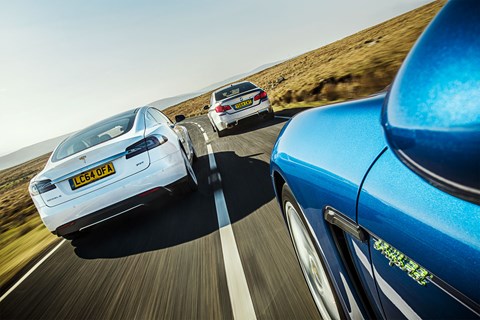
Leaving Bristol by 7am, we mingle with early morning traffic. The air-sprung ride is pretty sophisticated, the steering progressively weighted and accurate, and the refinement quite astonishing. Clearly, there’s no engine noise, but I’d expected tyre and wind noise to rush into the vacuum. They don’t. You’d be so blissed-out driving to work you’d need a nap on arrival.
Luckily the regenerative braking rouses you: it’s fierce. Backing off the accelerator is like hitting the brakes, so you must finesse your inputs for smooth progress. You can dial it back to a less aggressive setting that makes the driving range drop faster but, like switching the Porsche to Sport, doing so seems wrong, and anyway, I need to nurse the Tesla along to maximise B-road time. It’s like saving beer tokens for a Friday blow-out. By the time we’ve covered 90 miles to the Brecon Beacons, doing 70mph on the motorway and tickling cross-country, the Tesla says we have around 80 miles left – less than it’ll take to get back.
I park up, and jump in the BMW M5. This is the 30 Jahre Model, which celebrates, well, 31 years of the M5. For £92k you get a car limited to 300 units (30 in the UK), leather/alcantara seats, lowered sports suspension, Frozen Dark Silver paint, 20-inch rims, 16-speaker stereo, adaptive LED headlights…
The closest the M5 gets to hybridisation is a stop/start funtion that kills the engine at the lights, but there is an extra 39bhp – up to 592bhp – that, according to the EU combined cycle, comes entirely emissions free. There’s a range of settings that permit ferocious gearchanges and planet-destroying powerslides, and a noise from those carbon-tipped quad exhausts that drowns out eco-warriors with a toe-wobble.
The M5 looks and feels sensational. There are claims that the steering’s been re-jigged, but that’s underselling it: the 30 Jahre’s steering is stand-out fabulous, an alcantara-wrapped rim that jiggles in your hands like a GT3. The M5 is a big old barge, but the steering makes it feel tiny. Best sampled in Comfort mode, though: Sport and Sport Plus diminish the delicacy.
After the enforced restraint of the Tesla, it’s liberating to just jump in and blitz a road. The M5’s so nimble and light-footed, bites hard and clean into corners, and, because we’ve got £8k of ceramic brakes, stops like you’ve strayed into a crash-test lab.
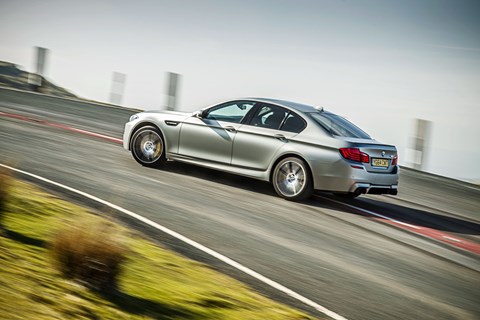
The M5 V8 pre-dates the disappointing new M3 engine, but proves that the sub-brand built on natural aspiration can do turbo. I love the response – yes, with a smidge of lag – the new-wave V8 sound, the urge through the midrange, and that magic transformatory phase as it manically runs for the redline.
The dual-clutch transmission is like nothing this side of a Ferrari: upshifts are punched through hard, down-shifts are instantaneous – pull the tactile left-hand paddleshifter four times in seventh gear and you’ll be in third in a blink of an eye – and it’ll waft in auto mode with the best of them.
The way the M5 puts down its power is equally impressive. Turn off the stability control and the trick M differential and, on dry tarmac at least, the 20-inch Michelins can cope. You have to push through that traction with determination, and then it’s incredibly benign, with a sense the slide will stop as soon as you stop mucking about.
A rare miss: a non-sporting Porsche
After the absolute thrill of the M5, the Panamera disappoints. It does the fast B-road stuff unwillingly, like a stubborn mule whipped through the Grand National. The performance is strained where you want it to soar, and the gear changes lack the M car’s ultra-definition. This is also one of few cars where the default Comfort air suspension mode feels too soft for the road, and it’s front and rear ends don’t quite gel.
Braking’s not too bad though. Under gentled retardation the electrical systems harvest energy, while pads, discs and calipers step in when you stand on the pedal. There is an odd feeling about halfway through the pedal travel, but it doesn’t jar like some hybrids.
The Panamera is far from awful to drive, but it simply doesn’t deliver an experience worthy of the badge, and nor does it capture the Tesla’s sense of driving into the future.
We’ve parked the Tesla for much of the shoot, scared of draining the battery. But I give myself five minutes to drive it like I stole it in a kind of reverse Mad Max scenario: a world full of resources and a car unable to use them. It’s surprisingly brilliant.
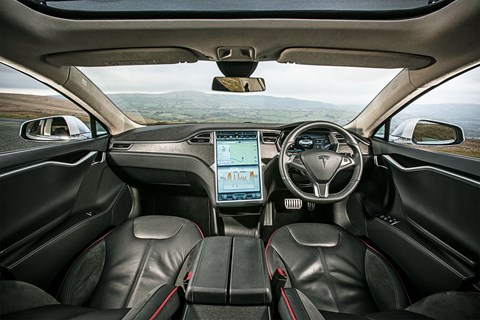
The electric motor serves up so much thrust from a standstill that it’s like being catapulted up the road in a tiny neon bouncy ball. Suddenly, the Tesla’s gear-less, constant stream of acceleration makes the M5’s state-of-the-art dual-clutcher feel anachronistic. Yes, there’s some body roll, no it doesn’t put its power down with the sophistication of the M5, but it stops, it steers and it’s genuinely, eye-openingly rapid point-to-point. It even does comedically big skids with its rudimentary traction control that won’t turn off, despite assertions to the contrary.
I can’t believe I’m saying this, but the Model S is more fun to drive than the Porsche. And this Model S is on 21-inch(!) winter tyres in temperatures too warm for them.
Then the Tesla goes and spoils it all by inexplicably jamming its sunroof open. CJ is left with 50 miles of range and a windy drive down the mountain. But even that can’t dull the promise of the Model S. He emails me from a recovery depot: ‘What really impresses is just how reassuring the Typical range value is, combined with the Predicted range. I recovered loads of mileage coming down from the shoot location, covering ground quickly, and at one point my Predicted range was above the Typical range. You could make it work for you without too much compromise.’
The Tesla does that to you, because it makes you feel like you’re part of a pioneering movement that’s pushing the boundaries of engineering. And at the end of the day, we covered 162 miles on a charge, left black lines up a mountainside, and still had a projected 36 miles in the tank. But a car for now, for me? It’s testament to Tesla’s brilliance that I feel like I’m in the dark ages saying it, but smoking tyres and burning fuel in the M5 still gets my £90k.
